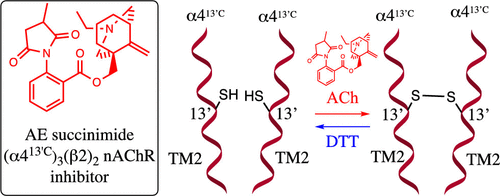当前位置:
X-MOL 学术
›
ACS Chem. Neurosci.
›
论文详情
Our official English website, www.x-mol.net, welcomes your
feedback! (Note: you will need to create a separate account there.)
AE Succinimide, an Analogue of Methyllycaconitine, When Bound Generates a Nonconducting Conformation of the α4β2 Nicotinic Acetylcholine Receptor.
ACS Chemical Neuroscience ( IF 4.1 ) Pub Date : 2020-01-14 , DOI: 10.1021/acschemneuro.9b00525 Taima Qudah 1 , Gracia X Quek 1 , Dinesh Indurthi 1 , Nasiara Karim 1 , Jill I Halliday 2 , Nathan Absalom 1 , Malcolm D McLeod 2 , Mary Chebib 1
ACS Chemical Neuroscience ( IF 4.1 ) Pub Date : 2020-01-14 , DOI: 10.1021/acschemneuro.9b00525 Taima Qudah 1 , Gracia X Quek 1 , Dinesh Indurthi 1 , Nasiara Karim 1 , Jill I Halliday 2 , Nathan Absalom 1 , Malcolm D McLeod 2 , Mary Chebib 1
Affiliation

|
Nicotinic acetylcholine (nACh) receptors are pentameric ligand-gated ion channels that mediate fast synaptic transmission. The α4β2 nACh receptor is highly expressed in the brain and exists in two functional stoichiometries: the (α4)2(β2)3 and (α4)3(β2)2 that differ by an ACh-binding site at the α4-α4 interface of (α4)3(β2)2 receptors. Methyllycaconitine (MLA) is an nACh receptor antagonist, and while potent at both α7 and α4β2 nACh receptors, it has a higher selectivity for the α7 nACh receptor. The anthranilate-succinimide ester side-chain is important for its activity and selectivity. Here we identify a simplified MLA analogue that contains only the A and E ring skeleton of MLA, AE succinimide, that binds close to the channel lumen to display insurmountable inhibition at α4β2 nACh receptors. Although inhibition by AE succinimide was found to be voltage-dependent indicating a possible pore channel blocker, substituted-cysteine accessibility experiments indicated it did not bind between 2'-16' region of the channel pore. Instead, we found that upon binding and in the presence of ACh, there is a conformational change to the channel membrane that was identified when the compound was assessed against (α4 V13'C)β2 nACh receptors. It was found that in the 3:2 stoichiometry the two adjacent α4 subunits containing 13' cysteine mutations formed a disulfide bond and occluded ion conductance. This was reversed by treatment with the reducing agent, dithiothreitol. Thus, AE succinimide has a different mechanism of inhibition to both MLA and other AE analogues, such as AE bicyclic alcohol, in that upon binding to an as yet unidentified site, AE succinimide in the presence of ACh induces a conformational change to the channel that generates a ligand-bound closed state.
中文翻译:

当束缚产生α4β2烟碱乙酰胆碱受体的非导电构象时,AE琥珀酰亚胺(甲基琥珀酸吗啡酮的类似物)。
烟碱乙酰胆碱(nACh)受体是介导快速突触传递的五聚体配体门控离子通道。α4β2nACh受体在大脑中高表达,并以两种功能化学计量存在:(α4)2(β2)3和(α4)3(β2)2,在α4-α4界面的ACh结合位点不同(α4)3(β2)2受体。甲基甘草酸碱(MLA)是nACh受体拮抗剂,虽然对α7和α4β2nACh受体均有效,但对α7nACh受体具有更高的选择性。邻氨基苯甲酸酯-琥珀酰亚胺酯侧链对其活性和选择性很重要。在这里,我们确定了一个简化的MLA类似物,它仅包含MLA的A和E环骨架,即AE琥珀酰亚胺,与通道管腔紧密结合,在α4β2nACh受体上显示出无法克服的抑制作用。尽管发现由AE琥珀酰亚胺的抑制是电压依赖性的,表明可能是孔通道阻滞剂,但是取代的半胱氨酸可及性实验表明,它不结合通道孔的2'-16'区域。相反,我们发现在结合并存在ACh时,通道膜发生构象变化,该变化是在针对(α4V13'C)β2nACh受体评估该化合物时确定的。发现在3:2化学计量中,含有13'半胱氨酸突变的两个相邻的α4亚基形成了二硫键并封闭了离子电导。通过用还原剂二硫苏糖醇处理将其逆转。因此,AE琥珀酰亚胺对MLA和其他AE类似物(例如AE双环醇)具有不同的抑制机制,
更新日期:2020-01-15
中文翻译:

当束缚产生α4β2烟碱乙酰胆碱受体的非导电构象时,AE琥珀酰亚胺(甲基琥珀酸吗啡酮的类似物)。
烟碱乙酰胆碱(nACh)受体是介导快速突触传递的五聚体配体门控离子通道。α4β2nACh受体在大脑中高表达,并以两种功能化学计量存在:(α4)2(β2)3和(α4)3(β2)2,在α4-α4界面的ACh结合位点不同(α4)3(β2)2受体。甲基甘草酸碱(MLA)是nACh受体拮抗剂,虽然对α7和α4β2nACh受体均有效,但对α7nACh受体具有更高的选择性。邻氨基苯甲酸酯-琥珀酰亚胺酯侧链对其活性和选择性很重要。在这里,我们确定了一个简化的MLA类似物,它仅包含MLA的A和E环骨架,即AE琥珀酰亚胺,与通道管腔紧密结合,在α4β2nACh受体上显示出无法克服的抑制作用。尽管发现由AE琥珀酰亚胺的抑制是电压依赖性的,表明可能是孔通道阻滞剂,但是取代的半胱氨酸可及性实验表明,它不结合通道孔的2'-16'区域。相反,我们发现在结合并存在ACh时,通道膜发生构象变化,该变化是在针对(α4V13'C)β2nACh受体评估该化合物时确定的。发现在3:2化学计量中,含有13'半胱氨酸突变的两个相邻的α4亚基形成了二硫键并封闭了离子电导。通过用还原剂二硫苏糖醇处理将其逆转。因此,AE琥珀酰亚胺对MLA和其他AE类似物(例如AE双环醇)具有不同的抑制机制,









































 京公网安备 11010802027423号
京公网安备 11010802027423号